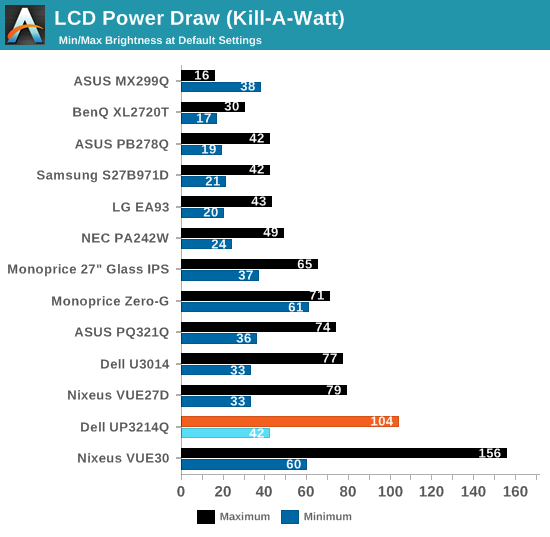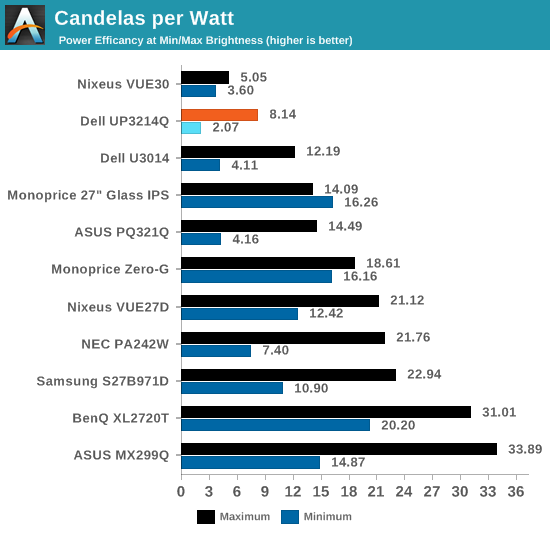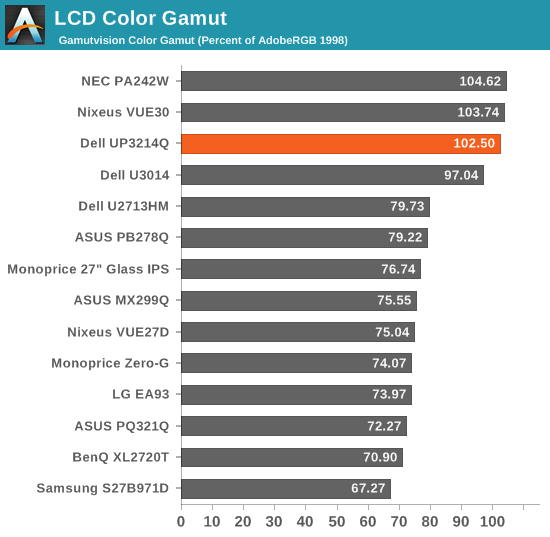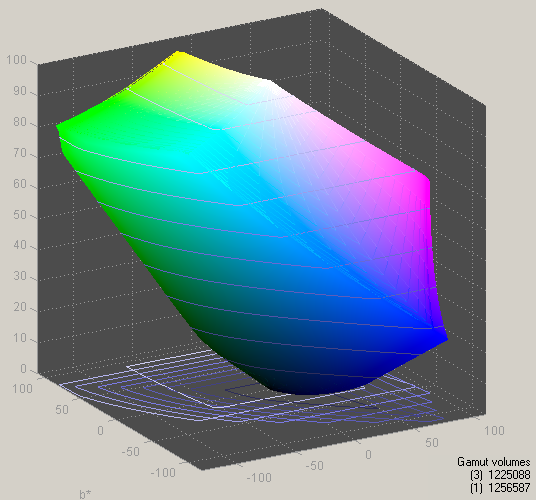Dell UP3214Q Review
by Chris Heinonen on April 1, 2014 12:00 AM ESTUsing the Leo Bodnar lag tester, I measure 47ms of lag on the UP3214Q using a 1080p signal. Without a game mode or anything else to speed up this processing, this is fairly slow. Most people probably won’t be playing many games at native UltraHD resolutions due to the graphics hardware required so measuring a non-native resolution signal, while never ideal, is probably closer to a real world situation here. For many people this will be too slow for gaming. This measurement is also done over HDMI, while almost everyone will use DisplayPort with this monitor to get 60 Hz, so that is another variable that might be different as well.

As a 32” display the UP3214Q is going to use power, and it consumes a decent amount. With the backlight at minimum is consumes 42 watts, and that climbs to 104 watts at maximum backlight. However this power use is still below the 30” Nixeus display that was recently reviewed, and even the 27” NEC PA271W professional display. The UP3214Q is less power efficient than either of those displays as they both have a higher maximum and minimum light output, even with the smaller screens.


The color gamut data has the same issue as the AdobeRGB data. A bug in the calibration has caused the gamut numbers to be off, so I’m reporting two different results. The one from my calibration is 82.7% of the AdobeRGB gamut. Using the included Dell ICC profile, it has 102.5% of the AdobeRGB gamut. Since the pre-calibration numbers appear to support the Dell ICC profile, I will say that the Dell UP3214Q supports the full AdobeRGB gamut as the specs say.












84 Comments
View All Comments
Taracta - Tuesday, April 1, 2014 - link
I don't know what is considered by many as HiDPI but this monitor is most definitely not HiDPI at just 140 DPI! I know that most highend monitors are ~ 100 DPI and common one are even lower but I don't see why 140 DPI would be such a big deal. Are the Icons that much smaller? Are the alphanumeric character unreadable?I believe the the ridiculously low DPI of generations of monitor has made expectation of huge icons and lettering the norm and they are just not needed. You can see the icons and characters perfectly fine at 140DPI no scaling is needed!
houkouonchi - Friday, April 4, 2014 - link
Yeah I think its just people set in their ways. Even when I had an out-dated prescription and saw worse than 20/20 I still would have no problem with that size. The only thing I can think of is that is just how most people have used computers and are stuck in their ways. I used 1600x1200 on a 17 inch CRT way back in the days (pre windows-2000) and soon after when I switched to linux I was 2560x1920 on a 22 inch CRT. It was even a bit blurry but it was still not a problem and that was 160 PPI. With a super sharp 140 PPI display why do people need scaling? I don't use scaling even on a 200 PPI+ display.JDG1980 - Tuesday, April 1, 2014 - link
Personally, I'd like to see a 39" 4K monitor, using the same VA panel in the Seiki TV but with a 60 Hz input. The Seiki TV is OK for productivity apps, but if you play any games or watch videos, as I do, then the low frame rate is a deal-breaker.A 39" monitor at 4K would provide an absolutely huge workspace - you would no longer need a multiple monitor setup. And the DPI isn't much higher than a standard 27" 2560x1440 monitor, so you don't need to use the Windows scaling that so many applications still don't do properly. (Microsoft really needs to do something about this - right now they seem content just to hope everyone eventually moves to Metro, which they aren't and won't.)
sk317bge - Tuesday, April 1, 2014 - link
Chris H. - does the Dell preset for Game exist? On my 24", the Game mode has less lag (by many milliseconds), with a tradeoff that the color is a bit too overdriven.GTVic - Tuesday, April 1, 2014 - link
May be UltraHD in comparison to a TV, but 138 DPI is something I would sneeze at. A 50% increase in pixel density compared to a standard 16:10 24" monitor with 94 DPI is not enough.lokitx - Tuesday, April 1, 2014 - link
Everyone should read this before purchasing this monitor: http://en.community.dell.com/support-forums/periph...praeses - Tuesday, April 1, 2014 - link
You mention the usefulness of contrast over brightness in this instance. As LED monitors do lose a notable amount of brightness over time, are you able to re-test the brightness of a monitor that you have previously tested and recorded the numbers on and report the differences?I suspect over the long term having a monitor that can go brighter than needed may be more useful than suspected.
Human Bass - Tuesday, April 1, 2014 - link
It was looking quite decent, but that lag, wow, seems like a motion blur city.cjl - Wednesday, April 2, 2014 - link
Lag does not cause motion blur. Lag is how long a display takes to react to an input, and is usually (in the case of displays like this) caused by a delay in the image processing circuitry in the display itself. Motion blur on the other hand would be caused by a slow pixel response time (where the pixels themselves take a long time to change states after the display has already begun to refresh).Death666Angel - Tuesday, April 1, 2014 - link
I'm more looking for the 28" Dell one, much better price/performance for me. 600€ is nearly as much as I paid for my 1440p monitor not that long ago. Incredible.